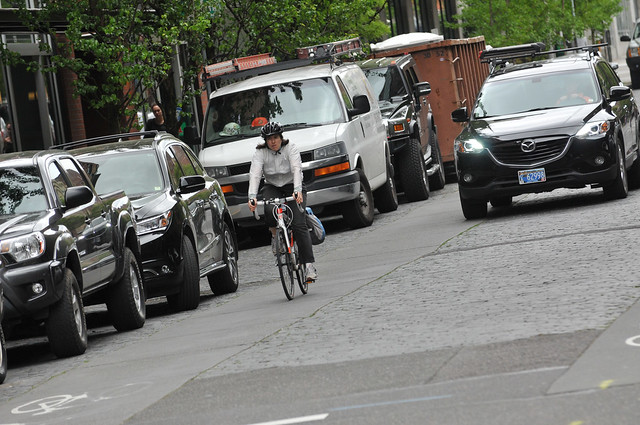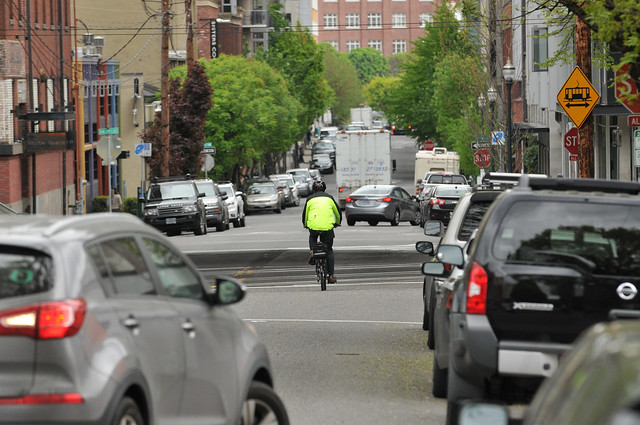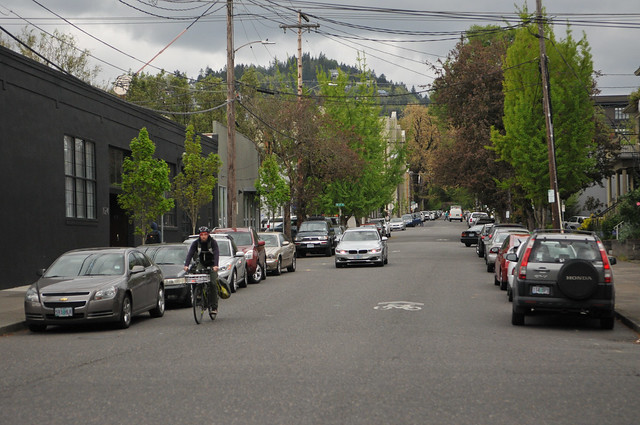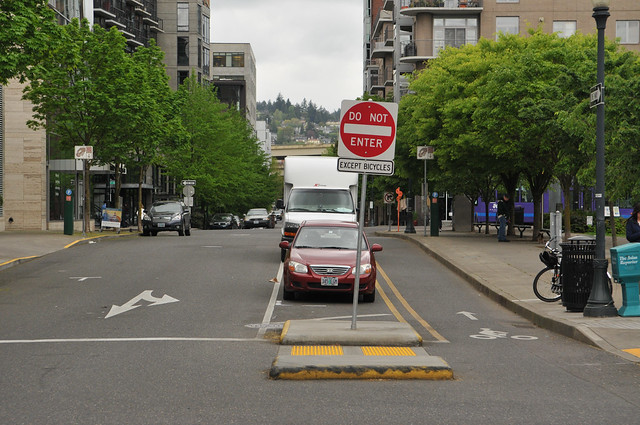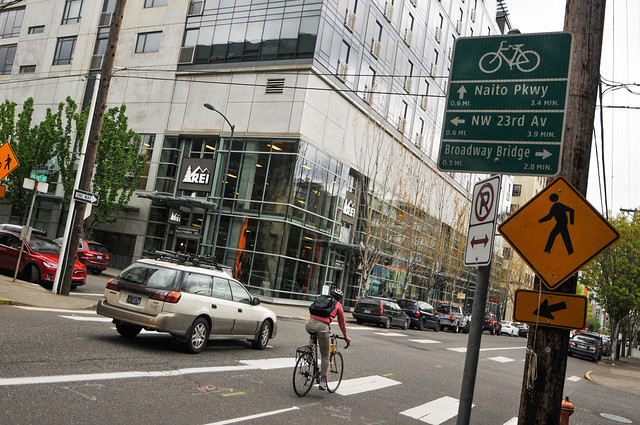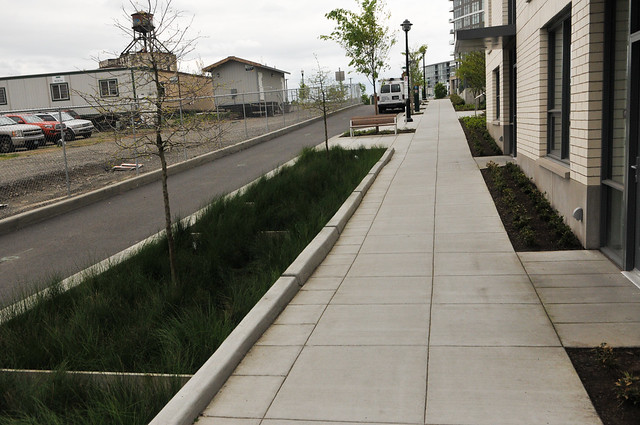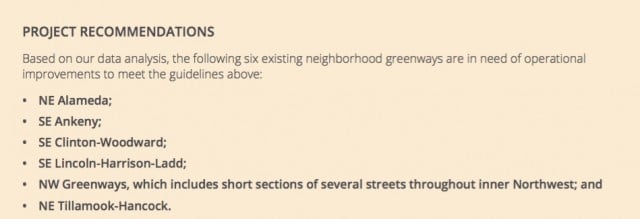
(Photos: J. Maus/BikePortland)
Part of NW Portland Week.
When you browse over to the Portland Bureau of Transportation’s neighborhood greenways website and follow the links to the list of current projects you’ll see that northwest is the only one of the five quadrants that has this sad note next to it: “PBOT currently does not have any new neighborhood greenway projects in Northwest.”
It’s a stinging reminder that this part of the city, a place with so much cycling potential, still lacks one of Portland’s best tools for encouraging cycling by the “interested but concerned.”
When it comes to the state of neighborhood greenways in northwest Portland, there’s good news and there’s bad news. The bad news is that they’re nearly two decades old, in need of major upgrades, and are smack-dab in the middle of an auto-dominated and change-resistant part of town. The good news is that advocacy to change this dynamic is heating up, the City of Portland has acknowledged the problem, and they’re finally working to remedy the situation.
The history and context
There are six neighborhood greenways in northwest listed on the city’s official map: 24th, Johnson, Flanders, Overton, Marshall and Raleigh. Five of those were established in the late 1990s long before the idea of “neighborhood greenway” was even a twinkle in the eye of city planners. And NW Marshall became a bike street only in 2012 as part of a swap when the streetcar kicked the bike lane off of Lovejoy.
While these streets are listed on the map as such; they don’t really deserve the neighborhood greenway label. “Apart from a few sharrows (many of them faded), you’d never know they were neighborhood greenways,” wrote Northwest Portland resident Scott Kocher in an email to us last week. “This is greenway inflation. Someone put them on a map so we could say we have “X” miles of neighborhood greenways, but there’s no there there.”
I rode these streets yesterday and Kocher is right. It’s hard to tell you’re on a street where biking has priority:
The Portland Bureau of Transportation would use different language to say it, but they agree with Kocher. PBOT Bike Coordinator Roger Geller said in a presentation last year that the existing greenways in northwest are, “a real problem area.”
“The automobile volumes on Northwest neighborhood greenways are likely a contributing factor to the low number of bicycles and overall ridership in the area.”
— From PBOT Neighborhood Greenway Assessment Report (2015)
PBOT’s 2015 Neighborhood Greenway Assessment Report (PDF) also acknowledges the problem: “The automobile volumes on Northwest neighborhood greenways,” it reads, “are likely a contributing factor to the low number of bicycles and overall ridership in the area.”
Along with a lack of the typical features that make neighborhood greenways work in other parts of town like speed bumps, 20 mph speed limits, stop sign priority for bike riders, diverters, and crossing treatments, the problem with these streets is that they simply have too many people driving on them.
National guidelines for bicycle boulevards (another name for neighborhood greenways) say they should have 1,500 cars per day or less. According to PBOT’s report, all of the northwest Portland greenways have over 1,000 cars per day and more than two-thirds of them have over 1,500 cars per day. Greenways in every other quadrant have much lower auto volumes.
A lack of traffic diverters on northwest’s bike streets is likely to blame for the auto overuse. The only piece of traffic calming infrastructure in northwest’s entire neighborhood greenway network is at 10th and Marshall where PBOT installed a median and contraflow bike lane in 2012.
To be fair to PBOT, back in the ’90s they didn’t have the understanding and data to analyze neighborhood greenways that they do now. Reza Farhoodi, a member of the PBOT Bicycle Advisory Committee and the co-chair of the Pearl District Neighborhood Association’s Planning and Transportation Committee says back then the city didn’t put much thought into where streets for cycling should go. “[They chose] whatever connected through. They didn’t put a whole lot of consideration into what the volumes and speeds would be.”
Thankfully things are changing. In the past year PBOT has made big strides in their neighborhood greenway program. After activists clamored for more diversion on inner SE Clinton Street PBOT responded with the assessment report and followed that up with significant infrastructure upgrades. The same future might be coming for northwest, but it won’t come easily.
Advertisement
The opportunities and challenges
While northwest’s bike streets have huge biking upside, they also pose unique challenges.
NW Overton, the street many of our readers say is their preferred east-west route, is as an emergency response route. This means it’s unlikely PBOT will be able to add calming features like speed bumps or diverters. Because of that limitation, there’s momentum among neighborhood advocates and PBOT staff to move the greenway designation from Overton to Pettygrove.
Local resident and author of the Next Portland blog Iain Mackenzie said Pettygrove would be a natural fit for bikes because it has specific design standards that mandate wider sidewalks, less parking, larger trees, and so on. But this could take time because inner Pettygrove is awash in new development right now. “The sections that are complete are really pleasant,” Mackenzie says, “but the piecemeal nature of its development means it wont be finished for a few years.”
Another issue in northwest is the lack of north-south bikeways. Of the six greenways on the city map today just one of them — NW 24th — runs north-south. Farhoodi, the neighborhood activist, says NW 9th should become a neighborhood greenway to provide a “backbone” for the existing east-west streets. “You could connect Naito, Overton, Marshall, Lovejoy, Johnson, and Hoyt.” He’d like to see a two-way path or cycle track on the east side of 9th.
It remains to be seen whether a plan like Farhoodi’s or even more modest changes likely to come from PBOT would be embraced or opposed by northwest neighborhoods. PBOT relies heavily on neighborhood support and endorsements to implement greenway projects. And unlike in other parts of town, greenways in northwest will go through both residential and commercial areas — which could make consensus even harder.
The future
The big news is that the wheels of change for northwest’s greenways are rolling. In their assessment report PBOT included “NW Greenways” as part of six neighborhood greenways that are “in need of operational improvements” to meet their guidelines.
“We will take a holistic approach in Northwest to figure out the strongest neighborhood network that we can deliver. As you like to say, ‘stay tuned…’”
— Greg Raisman, PBOT neighborhood greenways program manager
PBOT’s neighborhood greenway program manager Greg Raisman told us this week that three of those six projects are already underway (Clinton, Ankeny and NE Tillamook-Hancock). “We expect to address the NW Greenways… in the future and are currently seeking funding for these projects.”
Northwest’s neighborhood greenways also might get a boost thanks to the Portland Planning and Sustainability Commission. Just yesterday the PSC voted to support a new “access and circulation study” for the Northwest District in the Transportation System Plan. That study will (among other things), “Consider street reconfigurations and improvements including pedestrian and bicycle safety and access, travel directions, travel lanes, traffic control, and transit mobility and circulation.”
If new plans make your eyes glaze over (I don’t blame you), consider this: PBOT has recently hired a new staffer specifically to deliver small capital improvement projects like the speed bumps, median islands, and diverters that make greenways tick. Her name is Sheila Parrot and she’s already working with neighborhoods in southeast Portland to upgrade SE Ankeny.
As to whether PBOT can deliver those type of infrastructure upgrades to its bike streets in northwest, here’s how Raisman responded when I asked him that question earlier this week. “These will all be important questions when we begin conversations with the neighborhoods. We will take a holistic approach in Northwest to figure out the strongest neighborhood network that we can deliver. As you like to say, ‘stay tuned…'”
— Jonathan Maus, (503) 706-8804 – jonathan@bikeportland.org
Our work is supported by subscribers. Please become one today. .


